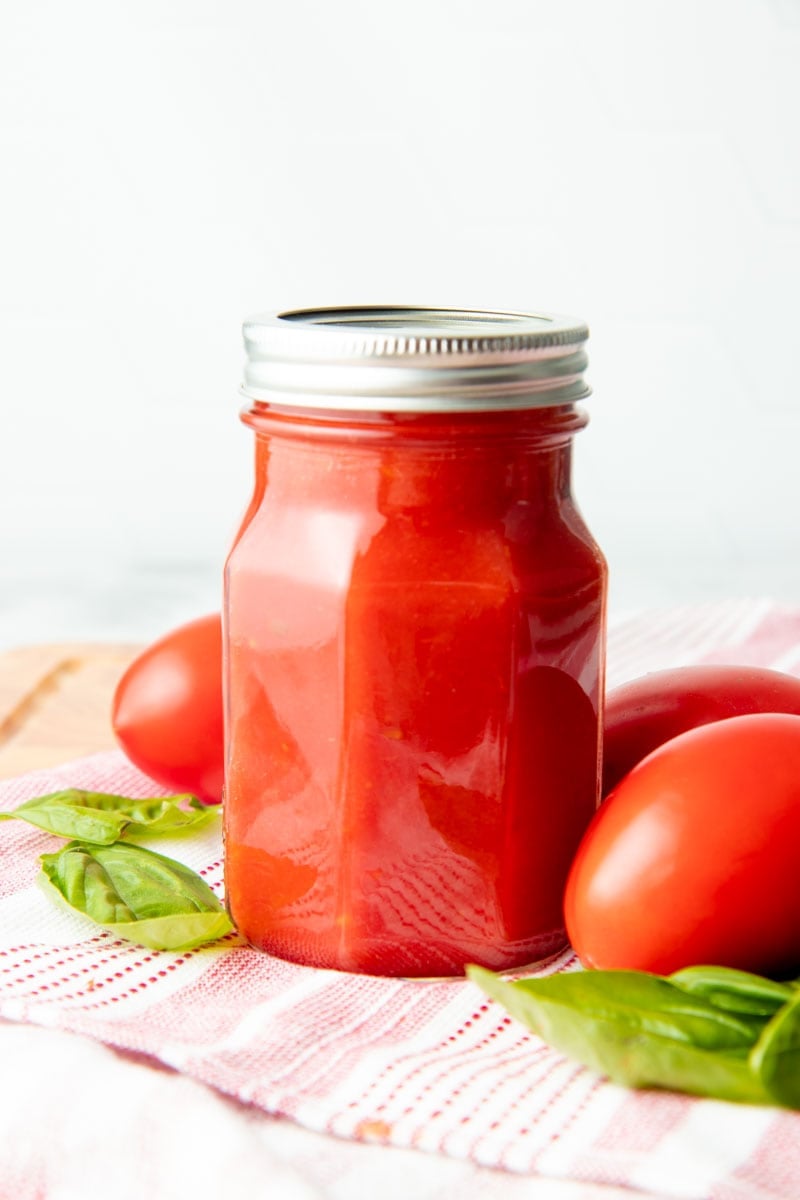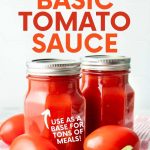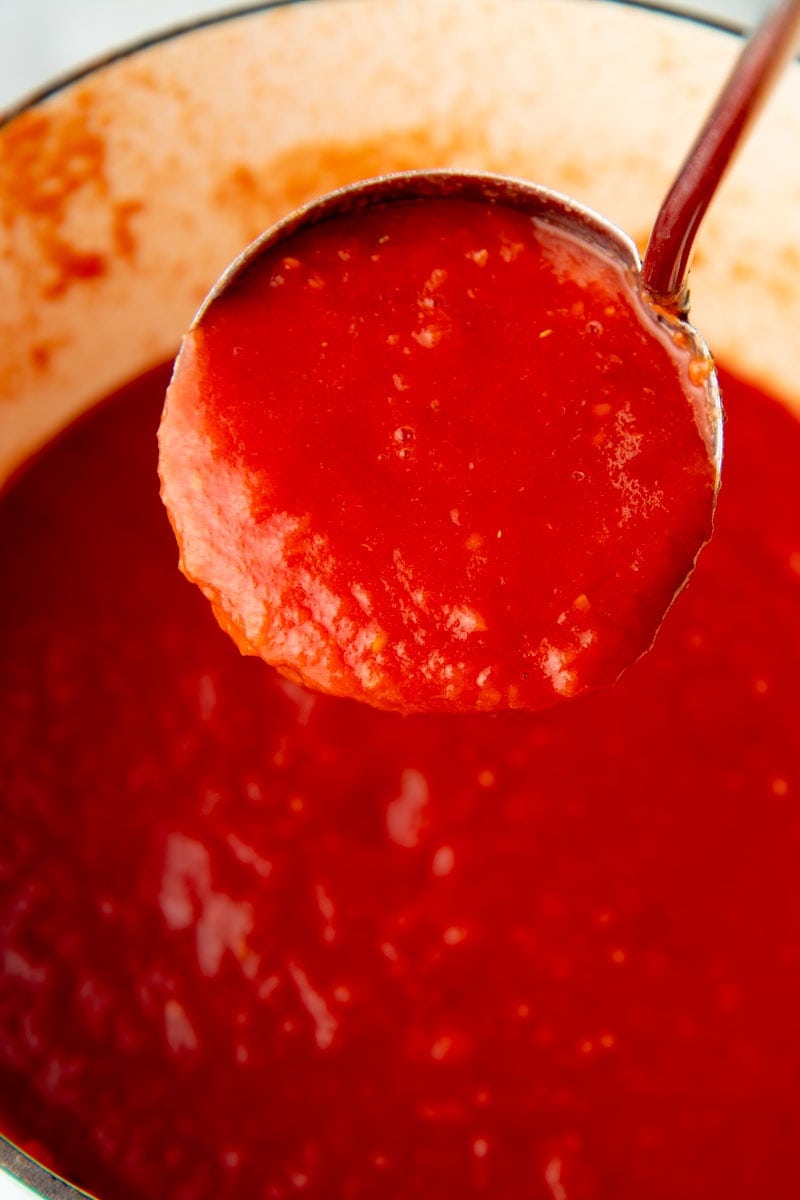As summer reaches its peak, gardeners around the country begin to patrol their tomato plots. They’re looking for that telltale rosy red hue that signals a tomato harvest is just around the corner! There’s nothing quite like a fresh tomato off the vine, but we’re often left with more tomatoes than we know what to do with.
Thankfully, this basic canned tomato sauce is a simple way to preserve your tomato harvest well into the winter months. The simplicity of this basic tomato sauce is what makes it super versatile. You can add some green peppers, garlic, and mushrooms to turn it into a pasta sauce, or add some spices and use it as the perfect pizza sauce for your homemade pizzas. It can be the base of a good pot of chili or you can turn it into the best enchilada sauce you’ve ever tasted. Let’s dive into canning!
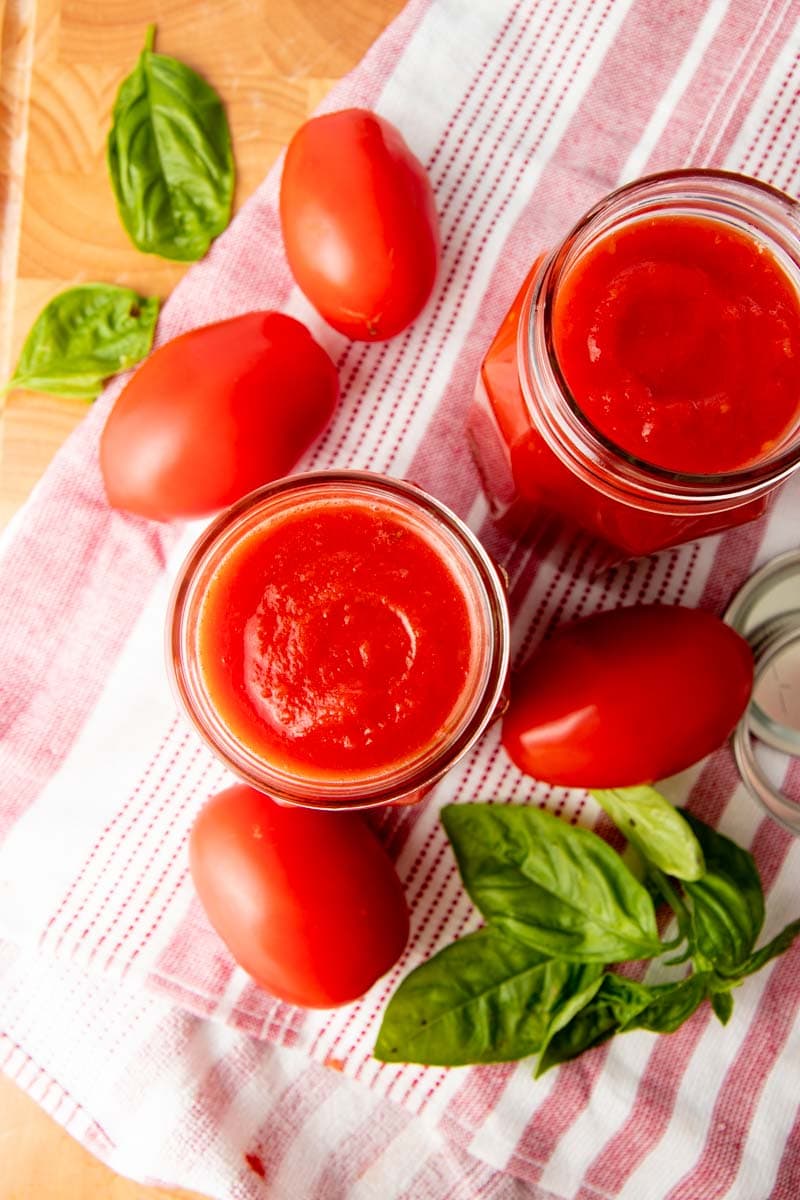
What’s the difference between tomato sauce, spaghetti sauce, and tomato puree?
There are a lot of different tomato-based sauces to keep track of! Here’s where to use what:
- Tomato Puree: This is a thick puree of either fresh or canned tomatoes that can be used in a lot of recipes in place of tomato paste.
- Spaghetti Sauce: This is a ready-to-use sauce seasoned with herbs and aromatic veggies that’s perfect tossed with some hot cooked pasta.
- Tomato Sauce (this recipe!): This is similar to tomato puree, but it is designed to be canned safely to make it shelf stable. This basic sauce just has two ingredients—tomatoes and an acidifier—and it’s a great base for spaghetti sauce, pizza sauce, chili, enchilada sauce, tomato soup, and lots of other delicious uses!

Does tomato sauce need to be pressure canned?
Tomato sauce rides the line between being a low-acid food that requires pressure canning and a high-acid food that can be water bath canned. Our recipe is a water bath canning recipe, so in order to can it safely, it’s crucial to use citric acid or bottled lemon juice to add acidity to your tomatoes to make an environment that is inhospitable for dangerous bacteria like botulism. You’ll find instructions for that in the printable recipe below.
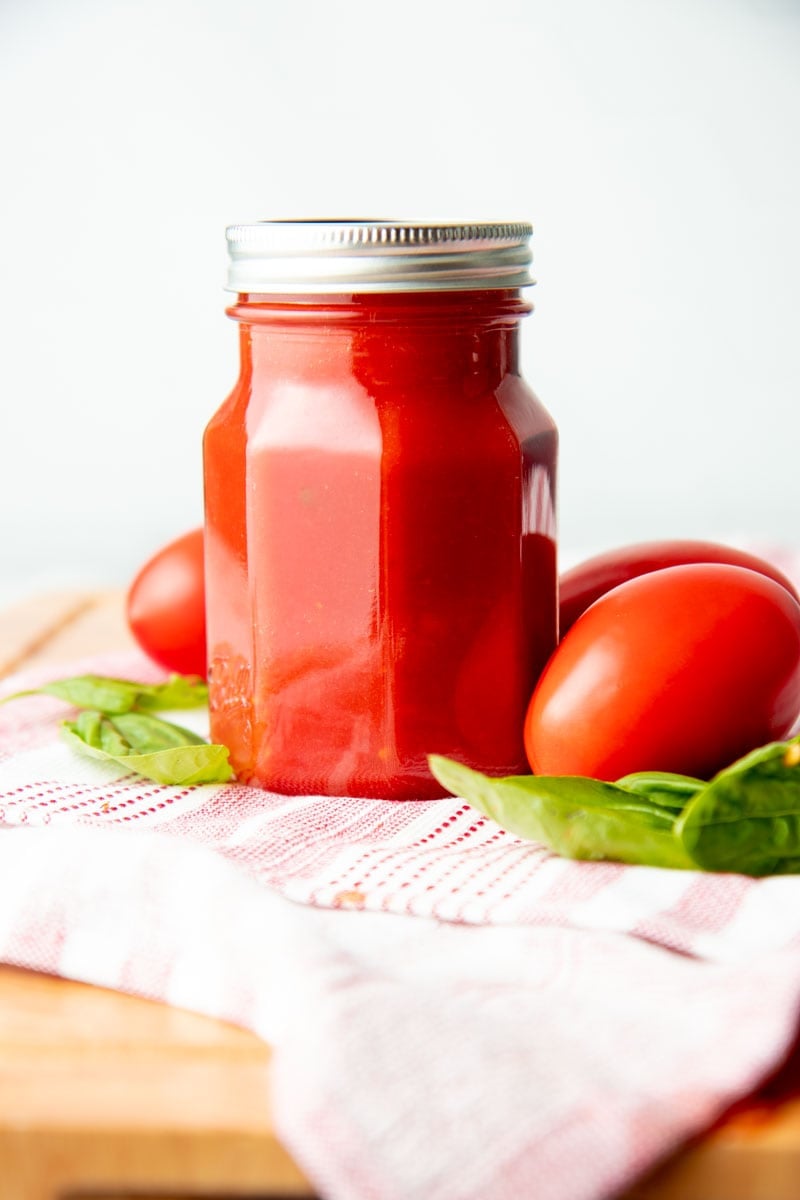
What are the best tomatoes to use for canning tomato sauce?
Plum tomatoes (AKA: paste tomatoes) are most often used in canning tomato sauce because they’re meaty and contain very few seeds. These tomatoes include romas, San Marzanos, and Amish paste tomatoes, and this type of tomato will give you more bang for your buck.
However, you can use any tomatoes that you have on hand when you’re making tomato sauce. I’ve made delicious tomato sauces using big beefsteak tomatoes, sweet cherry tomatoes, and grape tomatoes. Honestly, the best tomatoes for canning tomato sauce are the ones you have a lot of!
Protip: Save some cash!
If you are buying tomatoes from the farmers’ market or a local farmer, ask if they have a deal on “canning tomatoes” or “seconds.” Many farmers will offer a discount on tomatoes that aren’t pretty enough to sell in a stand but still make excellent sauce!
What do I need to can tomato sauce?
Not much! Most of what you’ll need you probably already have lying around your kitchen. To get started with water bath canning, you’ll need:
- A water bath canner—This can be a specific canner pot, or just a large stockpot—just as long as it’s large enough to fit a canning rack or canning trivet and is deep enough to cover your jars by at least 1-inch of water. You can often get water bath canning kits that come with a canning rack, a jar lifter, and a funnel.
- Lids, jars, and rings—These are easy to find in most hardware and grocery stores, especially in late summer and early fall when canning fever kicks in. Although you can reuse jars and rings, you cannot re-use the flat canning lids.
- Jar lifter—This strange pair of tongs is perfect for grabbing the top of your jars so you can lift them out of the boiling water. I’d really recommend getting a pair of these since freshly-canned jars are incredibly slippery!
- Sieve or food mill—This is how you’ll get smooth tomato sauce without any seeds or skins. We like both this manual food mill and this food mill attachment for our stand mixer. You can also use a regular metal sieve and a silicone spatula, although that method is a bit more tedious.
- Knives, funnels, chopping boards, clean dishtowels, and a few other general kitchen tools that you probably already own.
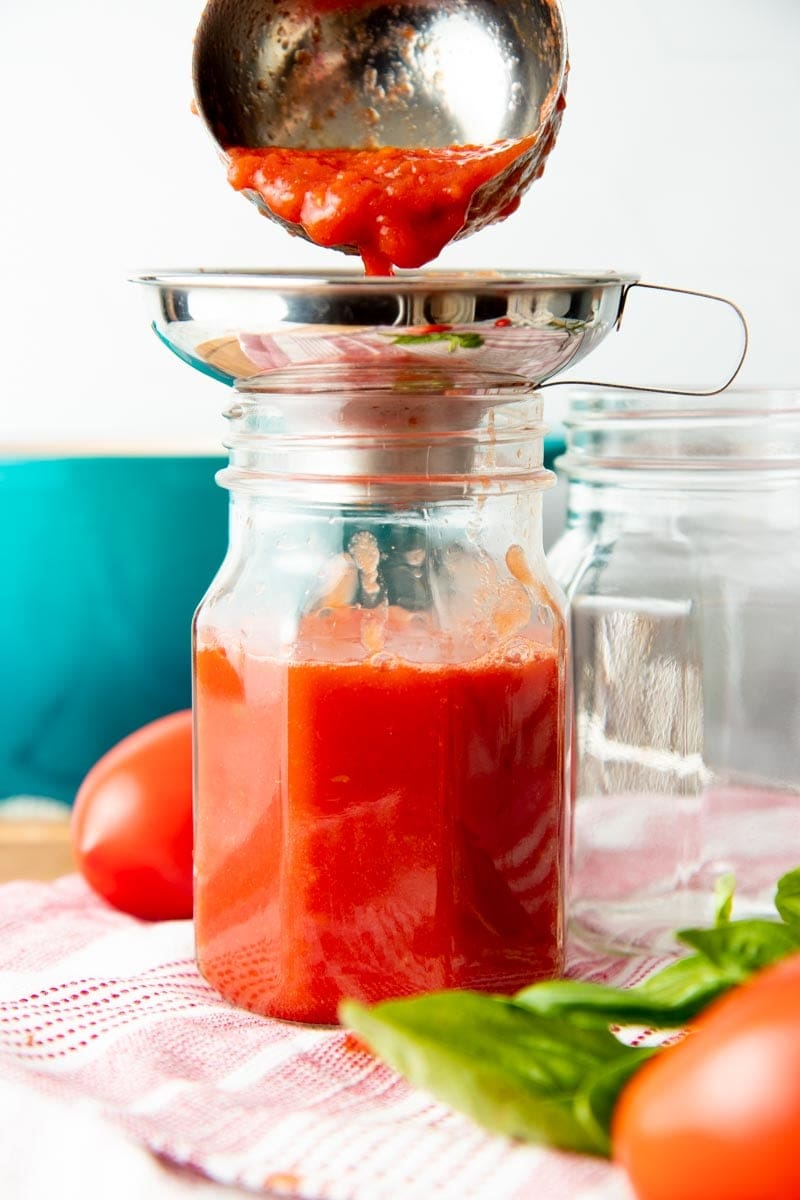
Tell me about canning tomato sauce!
Tomato sauce is a great beginner recipe because it only takes two ingredients: fresh tomatoes and some citric acid or bottled lemon juice. Here’s how to make your sauce:
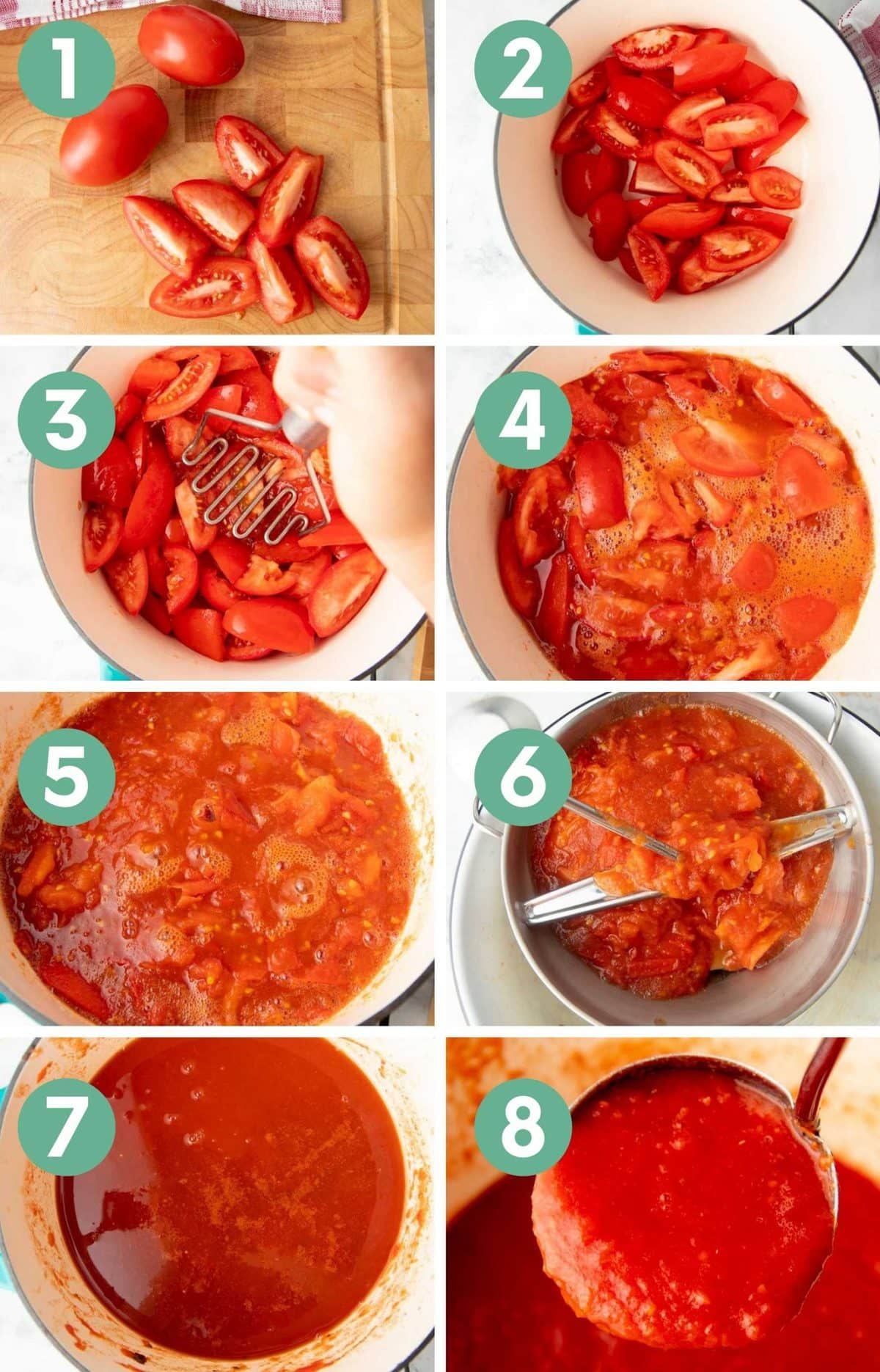
- Wash your tomatoes and cut them into quarters.
- Place a single layer of tomato quarters into a large pot over medium-high heat.
- Using a potato masher, mash the tomatoes until they begin to get soft and release their juices. Add in another layer of tomatoes, and keep mashing.
- Continue adding tomatoes and mashing until all tomatoes are added.
- Cook over medium-high heat until the tomatoes are soft and very juicy.
- Place a food mill fitted with the medium screen over a heat-proof bowl. Scoop the tomatoes into the food mill and process all the tomatoes until all that’s left is dry-ish tomato skins and seeds.
- Pour the thin tomato sauce back into the cooking pot, and heat over medium-high heat until reduced by about 1/3 for thin sauce or by 1/2 for a thicker sauce.
- Use the instructions below to preserve the tomato sauce for later.
Protip: How many tomatoes?
You’ll need about 5 pounds of tomatoes per quart of finished tomato sauce.
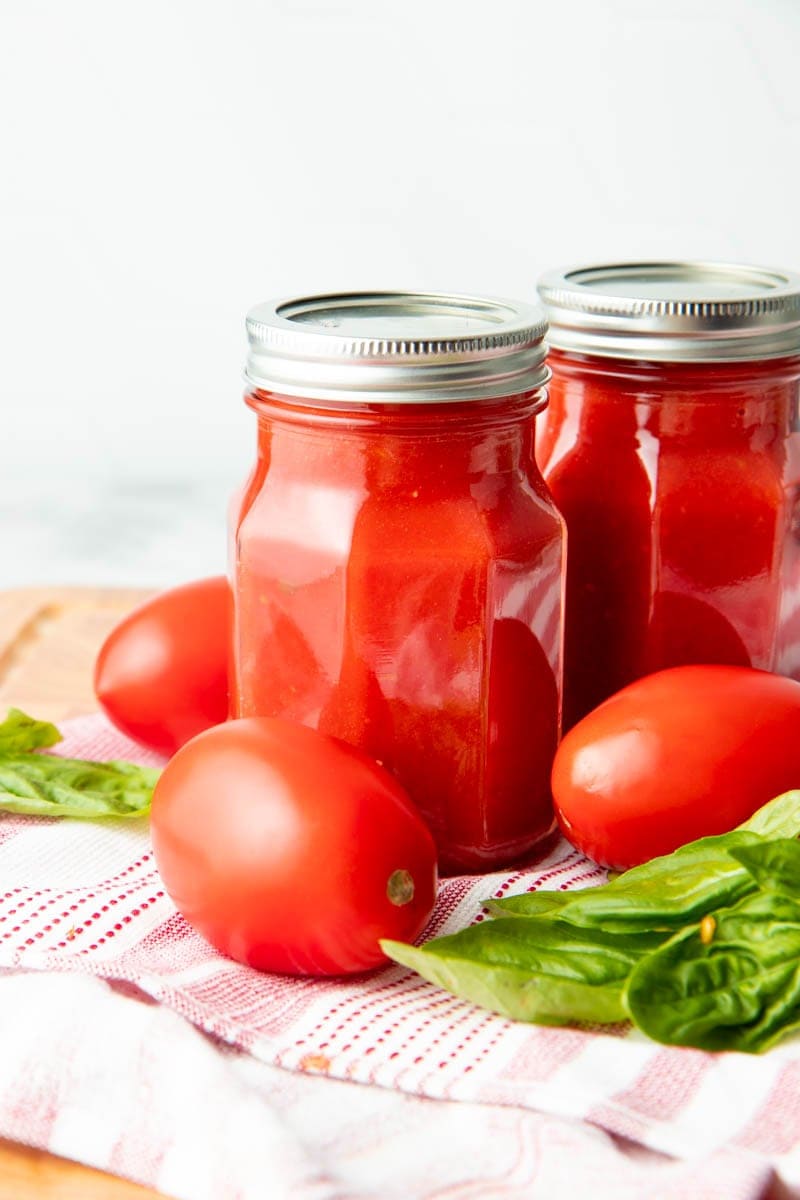
How do you can the tomato sauce for use later?
It’s such a dinnertime win to have jars of this basic tomato sauce on the shelf. Here’s how you can it to make it shelf-stable:
- Get your lids, rings, and jars ready by following the steps in our intro to canning post.
- Prep your tomato sauce as above.
- Add citric acid or bottled lemon juice to the bottoms of your jar. How much you add will depend on the size of jars you’re using. Add ¼ teaspoon of citric acid or 1 tablespoon of lemon juice for a pint jar. For a quart jar, add ½ teaspoon of citric acid or 2 tablespoons of lemon juice.
- Ladle your sauce into the jars, making sure to leave ½ inch headroom. Remove any air bubbles and adjust the headspace back to 1/2″.
- Wipe the rims of the jars clean and top with lids, tightening until just fingertip-tight.
- Lower into the water bath canner and process in boiling water. Pint jars should be processed for 35 minutes, while quart jars will be processed for 45 minutes. If you are at high altitude, these times may need to be adjusted.
- Remove jars and place in a cool, dry spot for 12-24 hours. You might hear a “pop” when they seal. To check if the jars are sealed properly, press on the center of each lid. If they pop up and down, the jar didn’t seal properly, and your sauce should be refrigerated and used within a few days.
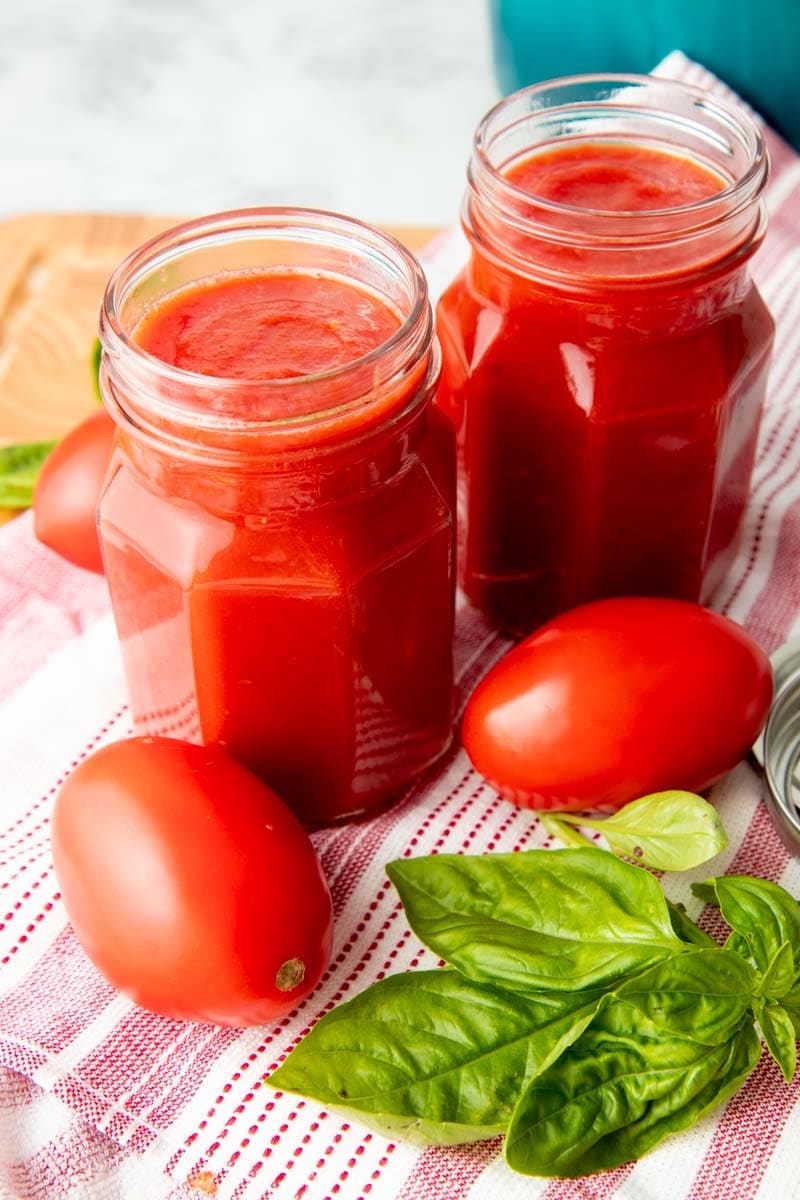
Do you have to put vinegar or lemon juice in canned tomato sauce?
Yes! Some type of acidic addition is necessary when canning tomato sauce because tomatoes on their own are right on the line between what is safe to can in a water bath canner and what isn’t. Adding citric acid or bottled lemon juice will make the mixture acidic enough to safely can.
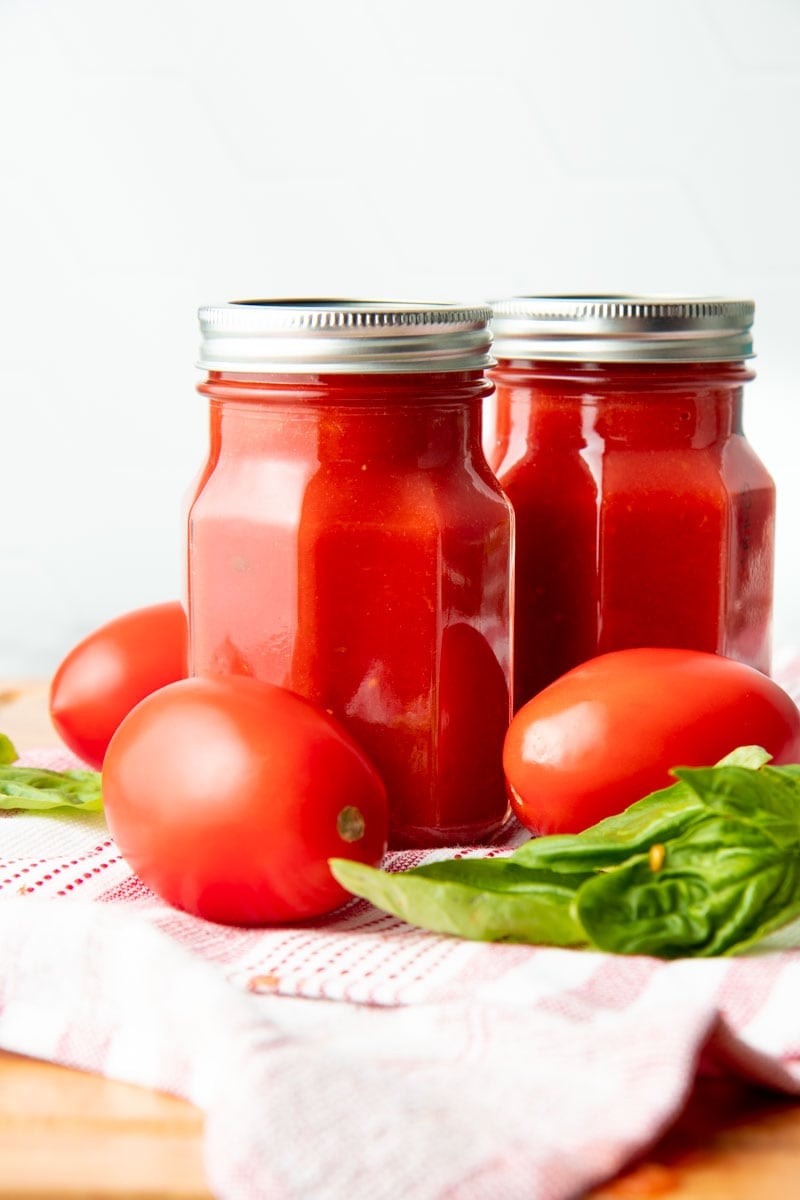
Do I have to peel the tomatoes first?
Nope! Through the process of making the tomato puree, you’ll remove the peels with a food mill. We do recommend removing the peels before canning. While some people believe that leaving the skin on helps add some thickness to your tomato sauce, we’ve found that the skins toughen up too much during canning and lead to unappetizing chunks in the final sauce.
Can you freeze homemade tomato sauce instead of canning?
You sure can! When freezing homemade tomato sauce, make sure you’re using proper freezer-safe jars (the ones with straight sides and no shoulders), and never fill them past the line on the side of the jar. Your homemade tomato sauce should keep safely in the freezer for four to six months.
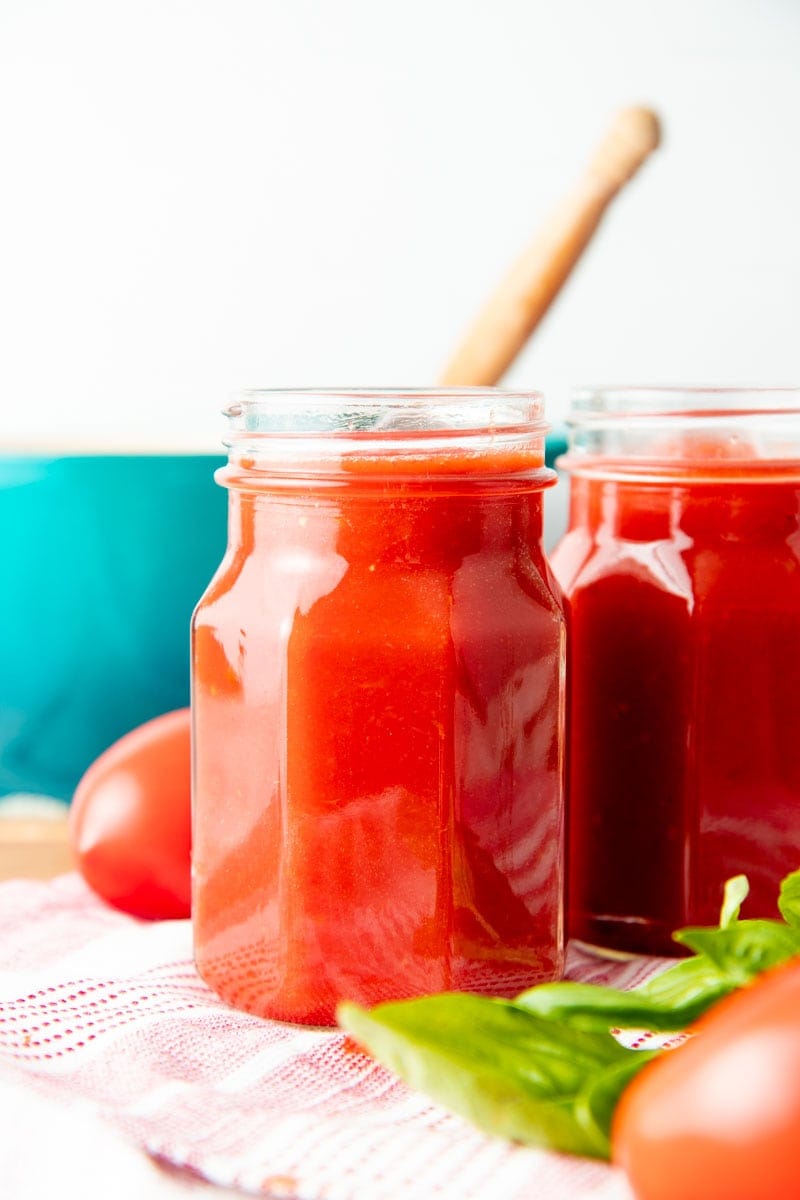
Why do my jars have less sauce in them than when I put them in the canner?
Tomato sauce is especially prone to siphoning, which is when liquid is pulled from the jar as it cools after canning. Don’t worry—it happens to everyone sometimes, and your tomato sauce is still safe to eat and store at room temperature as long as the seals are good. Press on the center of the lid after it has had time to cool—if it doesn’t pop up and down, you are good to go!
To keep it from happening next time, after canning, leave the jars in the water with the heat off and canner lid off for 5 minutes before moving them to a folded towel to cool completely. A slower cooling process means less siphoning!
How long will canned homemade tomato sauce keep?
Canned homemade tomato sauce will keep for at least 18 months. Make sure that the jars are kept in a cool, dry location that’s out of direct sunlight. Test your seal before opening, and if it’s still intact, your sauce is still safe to eat. Past 18 months, properly canned tomato sauce is still safe to eat, but the quality may begin to drop.
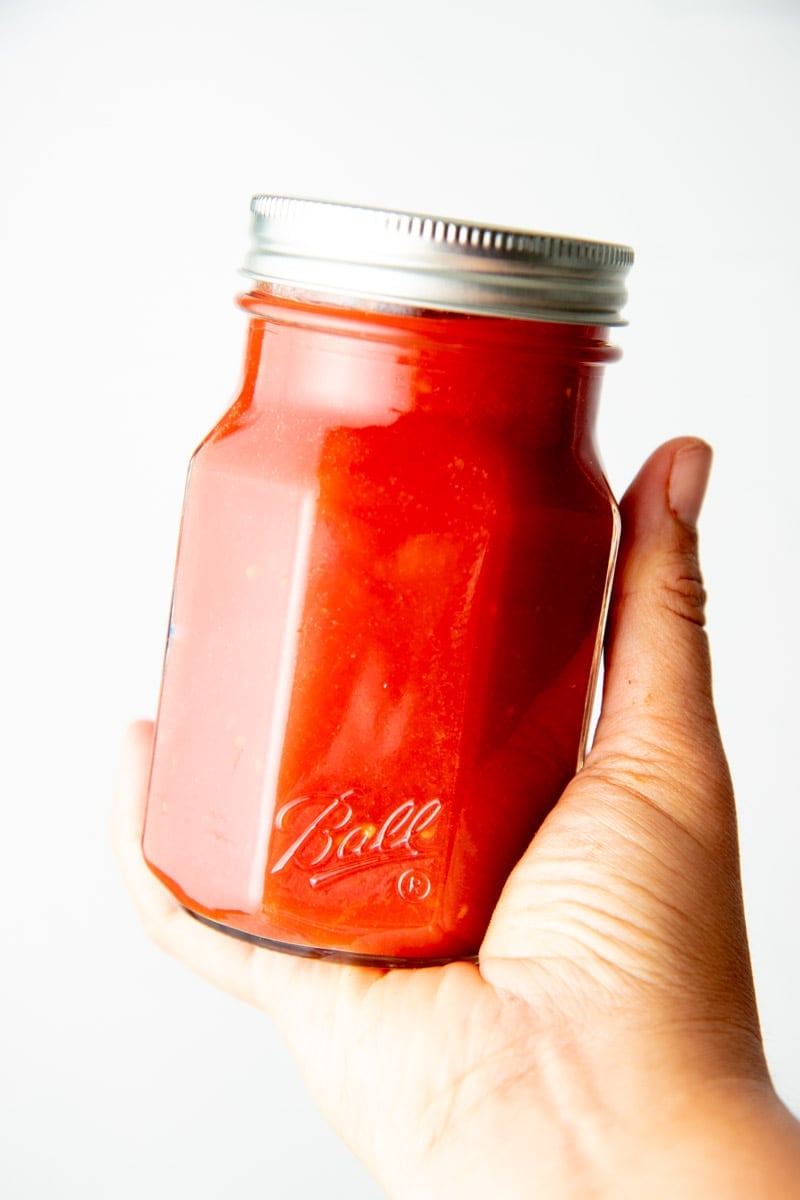
Can I add other vegetables to this tomato sauce?
In order to keep the tomato sauce safe for water bath canning, it is vital that you stick to the exact ingredients and amounts that we listed below. Ingredients such as onions, garlic, carrots, or celery will all make your sauce less acidic and not safe for the water canner. This tomato sauce is meant to be used as a base ingredient that you can transform into a number of different dishes.
If you’d like to can some sauce that is ready to be poured on pasta or pizza straight out of jar, we recommend our spaghetti sauce recipe instead.
Want more simple canning recipes like this one?
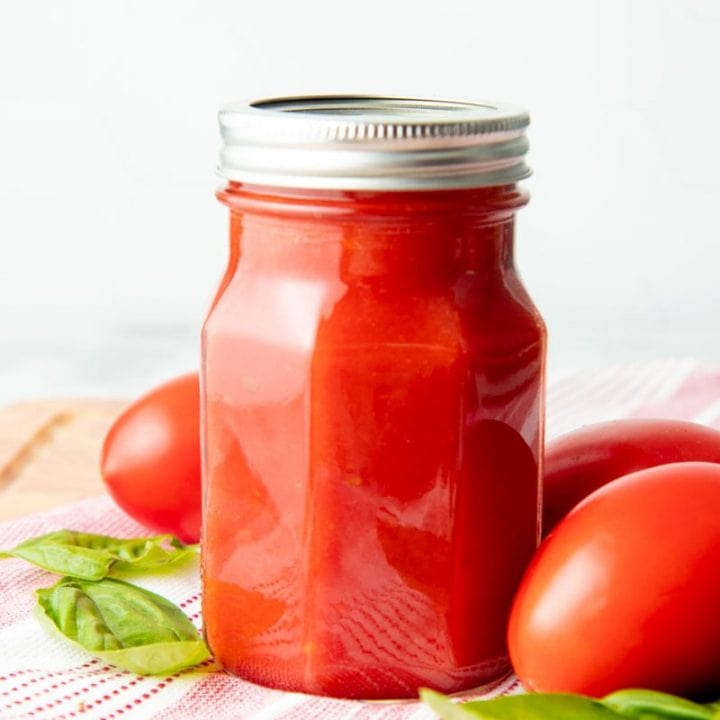
Canned Tomato Sauce Recipe
Canning tomato sauce is a good way to preserve tomatoes for long-term storage. Learn how to safely can your tomatoes in this complete guide—from prepping the tomatoes to picking the right jars.
Ingredients
- 20 pounds tomatoes (about 80 plum tomatoes)
- Citric acid or bottled lemon juice
Instructions
- Wash tomatoes. Core and cut tomatoes into quarters.
- Place a single layer of tomato quarters in the bottom of a large saucepan. Mash with a potato masher, and heat over medium-high heat until juicy.
- Add in the remaining tomatoes in 3-4 batches, mashing after each addition. Once all tomatoes are added, simmer until tomatoes are tender and juicy.
- Remove from heat. Run the tomatoes through a food mill to remove peels and seeds.
- Return purée to saucepan. Cook purée, uncovered, over medium-high heat until purée thickens, stirring to prevent sticking. Cook until volume is reduced by one-third for a thin sauce, or one-half for a thick sauce.
- Prepare boiling water canner. Heat jars in simmering water until ready to use, but do not boil. Wash lids in warm soapy water and set aside with bands.
- Add ¼ teaspoon citric acid or 1 tablespoon bottled lemon juice to a hot pint jar; ½ teaspoon citric acid or 2 tablespoons bottled lemon juice to a hot quart jar. Ladle hot sauce into hot jar, leaving ½-inch headspace. Remove air bubbles and adjust for headspace. Clean jar rim. Center lid on jar and adjust band to fingertip-tight.
- Place jar on a canning rack in the boiling-water canner. Repeat until all jars are filled.
- Cover the canner and bring water to a boil. Process pint jars 35 minutes or quart jars 45 minutes, adjusting for altitude. Start timer once the water is at a full, rolling boil.
- Turn off heat, remove canner lid, and let jars stand 5 minutes. Remove jars and cool for 12-24 hours on a folded towel. Check lids for seal—they should not flex when center is pressed. Label and store jars.
Notes
- You can safely add dried herbs to your tomato sauce jars to add flavor to this basic sauce. Here are a few options: Italian tomato sauce—Add 1/2 teaspoon each of dried basil and oregano, 1/4 teaspoon garlic powder, and a small pinch of red pepper flakes to each pint jar before packing with tomatoes. Tex-Mex diced tomatoes—Add 1 teaspoon chili powder, 1/2 teaspoon each cumin, oregano, and coriander, 1/4 teaspoon garlic powder, and a small pinch of red pepper flakes to each pint jar before packing with tomatoes.
- We prefer to leave our jars unsalted, but if you want to season your tomatoes before canning, add 1/2 teaspoon of salt per pint jar at the same time you add your citric acid or lemon juice.
- Tomatoes (and in particular tomato sauce) are prone to siphoning—where some of the liquid is pulled out of the jar from the pressure building up. As long as your jar seals properly, it's still safe to enjoy, even if some of the sauce has siphoned out. To reduce siphoning, when processing time is up, make sure to turn off the canner, remove the lid, wait 5 minutes, then remove the jars.
Nutrition Information:
Yield: 64 Serving Size: 1/2 cupAmount Per Serving: Calories: 26Total Fat: 0gSaturated Fat: 0gTrans Fat: 0gUnsaturated Fat: 0gCholesterol: 0mgSodium: 7mgCarbohydrates: 6gFiber: 2gSugar: 4gProtein: 1g
At Wholefully, we believe that good nutrition is about much more than just the numbers on the nutrition facts panel. Please use the above information as only a small part of what helps you decide what foods are nourishing for you.

